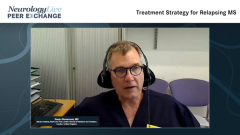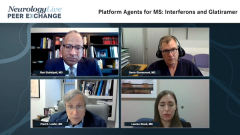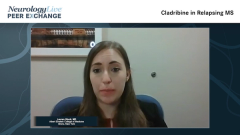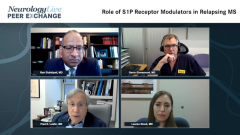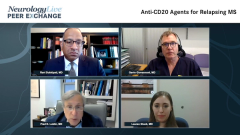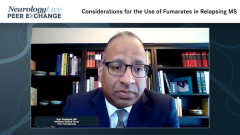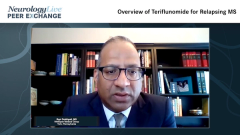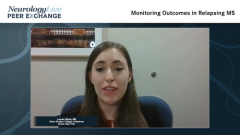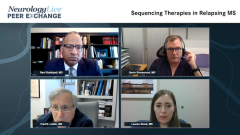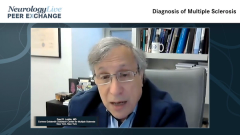
Cladribine: History and Mechanism of Action in MS
Gavin Giovannoni, MD provides an overview of the development and pharmacodynamics of cladribine in multiple sclerosis.
Episodes in this series

Fred D. Lublin, MD: Let’s move on to some of our newer agents. The oldest of the new agents would be cladribine [Mavenclad]. Most of the clinical trials were done a bit in the past. It just recently got approval and is probably the least well-understood drug of the medications that we prescribe. Tell us a little bit about the development of cladribine.
Gavin Giovannoni, MD: Cladribine development, Fred, goes back to the 1970s and 1980s, when Scripps Coulson was trying to recapitulate bone marrow metabolism. They saw these children with SCIDS, severe combined immune deficiency syndrome, elect CMV [cytomegalovirus] lymphocytes, and the mutation was in the adenosine deaminase enzyme [ADA]. We know that’s the enzyme that breaks down purine analogues. They created a family of purine analogues that was resistant to adenosine deaminase breakdown. Their theory was that you can deplete B and T lymphocytes and recapitulate the in one era. You can use this to treat mainly lymphomas at that time. One of the class of agents they discovered was 2-chlorodeoxyadenosine [cladribine], which is cladribine. It’s resistant to breakdown by adenosine deaminase, but the interesting thing about cladribine is that it is inactive and must be activated by being phosphorylated. That’s what is so interesting about the compound. By pure chance, its cells are only lymphocyte [lymphoid] lineage that expresses phosphorylating enzymes, which is DCK, or deoxycytidine kinase, and very particularly high levels in B cells. T cells, outside of the lymphocyte population, have very low DCK levels in other tissues, which is why the drug is so selective for B and T lymphocytes. When inactive, a patient may experience very few Git adverse effects [dryness in mouth, sleepiness, stomach pain, diarrhea, headache]. It’s transported into the cell, gets triphosphorylated, and gets incorporated into the DNA. The other thing that people need to be aware of is that it doesn’t only target dividing cells, but also nondividing quiescent cells, so it affects cells that aren’t dividing. In the mechanism, why it kills cells is probably not by being cytotoxic. It triggers apoptotic mechanisms because it gets incorporated into DNA, the DNA polymerase enzyme extends the DNA strand, and that triggers apoptosis. Apoptotic cells don’t die by cell lysis, but by phagocytosis. So there is no “cell lysis syndrome” with the drug, which is another benefit. In terms of the peak pharmacodynamics, the lymphocyte depletion gradually occurs over weeks-to-months, not over minutes-to-hours. It happens during depletion, so there are no infusion reactions. What we begin to realize is that it depletes the B-cell population—particularly the memory B-cell population—more selectively than other cell populations. It decreases the T-lymphocyte population about 40% to 50%, and because of that, it has a very interesting safety profile since we haven’t seen a major opportunistic infection signal. It allows B cells to reconstitute from the bone marrow,so that comes back on the naïve B cell population, and then people are vaccine ready—which is very relevant in the current climate because with COVID-19, you want to be able to respond to your vaccines. I personally don’t think the lymphocyte count is depleted to a level that blunts the vaccine responses in general but the memory B-cell population stays flat for months-to-years. I think that’s how the drug is working as a selective, memory B-cell population.
At least if the innate immune system is intact, it doesn’t really drop neutrophils and monocytes populations, etc., to a level that is clinically significant. It differs from some of the sledgehammers, as I call them, like alemtuzumab Lemtrada, and bone marrow transplant. The way we are using it is selective depletion; allowing reconstitution, and when the reconstitution occurs, the immune system is relatively intact. As far as we know, you are competent to fighting infection, tumor surveillance is intact, and vaccine responses are intact, so it has the ability to put people into remission, yet leave the immune system competent. This is the advantage of that class of therapies to be honest with you. We are quite surprised at the trial results. There’s a high efficacy DMT [Dimethyltryptamine], particularly in the more active populations. In fact, on relapse, DMT is over 60% to 65%, and its impact on disability preparation confirmation to 3 months was over 80%, which is as high as any other high efficacy DMTs we have available.
Fred D. Lublin, MD: Thank you all for watching this Neurology Live® Peer Exchange™. If you enjoyed the content, please subscribe to our e-newsletters to receive upcoming peer exchanges and other great content right in your inbox. Thank you for joining us.
Transcript Edited for Clarity
Newsletter
Keep your finger on the pulse of neurology—subscribe to NeurologyLive for expert interviews, new data, and breakthrough treatment updates.

